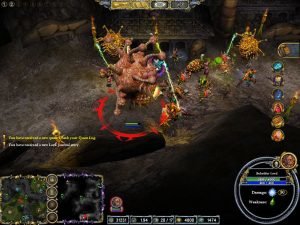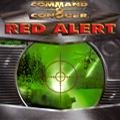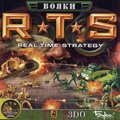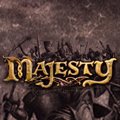Dragonshard
 Although drawn from D&D’s quasi-steampunk Eberron campaign setting, the three playable races in Dragonshard all conform to immediately recognizable RTS tropes. The Order of the Flame is your standard anthropomorphic bunch of humans, elves, and dwarves; the Lizardfolk are reptilian, tribal, green, and Zerg-like, and the dark, creepy Umbragen are the thalidomide stepchildren of the undead and Protoss, the austere, no-nonsense worshippers of chaos and haunted technology that no RTS would be complete without.
Although drawn from D&D’s quasi-steampunk Eberron campaign setting, the three playable races in Dragonshard all conform to immediately recognizable RTS tropes. The Order of the Flame is your standard anthropomorphic bunch of humans, elves, and dwarves; the Lizardfolk are reptilian, tribal, green, and Zerg-like, and the dark, creepy Umbragen are the thalidomide stepchildren of the undead and Protoss, the austere, no-nonsense worshippers of chaos and haunted technology that no RTS would be complete without.
Unlike most RTS games that let you build anywhere, Dragonshard forces you to make broad tactical choices right from the start. Radiating from the four sides of your main HQ are four quads of four “blocks,†each of which can support sixteen buildings. Each can produce one of ten unit types, but the number of production facilities also governs how many units you can make. Placing more buildings of the same type adjacent to one another also lets you level up units by spending the experience points you collect by finishing quests and killing monsters and opponents. Higher-level units get more hit points and mana, deal more damage, and gain access to more powerful abilities.
Alternatively, you can build monuments for global enhancements to your units, like damage bonuses or faster movement. With limited real estate and replenishable resources, it’s common to raze and switch out buildings on the fly, depending on your needs of the moment. Some units harvest resources faster, for instance, but can be phased out once your armies are big enough to shore up the difference. As a turtling deterrent, your base defenses are limited to initially useless walls and towers, although they can be upgraded to shoot projectiles at invaders and automatically repaired during battle. Expansions consisting of only four blocks apiece lie scattered across most maps but can’t be structurally reinforced.
The game’s two primary resources are gold and dragonshards. Although gold is accrued automatically at a sluggish rate, sparkling heaps of it can be won by delving into underworld dungeons with your units via well-marked entrances located around the map. Once inside, you get to kill monsters and open chests, some of which are accessible only to high-level rogues. Dragonshards, which bear a more than passing resemblance to StarCraft’s mineral deposits, can be found only on the surface, strewn in tidy clusters after they periodically rain down from the sky. Both resources are necessary to make units, and, considering how small most of the maps are, battle over fluctuating resource locations tends to constitute much of the gameplay. To help hasten such confrontations, each race conveniently comes with a unit that harvests resources faster. When promoted to level two, they can cast a Find Resources spell that lifts the fog of war momentarily to show the locations of the latest shardfalls.
 Resources are only one variable to consider. Giant shrines called Places of Power—found both above and below the surface—grant global stat bonuses to your units, and you can win instantly if you maintain control of a majority of these for three consecutive minutes. You can also win by finding and controlling four “seals of light,†hazy white artifacts that drop randomly off monsters underground. The catch is that when you pick one up, the carrying unit’s location is revealed to all players until it reaches home, leaving it vulnerable to interception en route. Thankfully, this stuff can be disabled.
Resources are only one variable to consider. Giant shrines called Places of Power—found both above and below the surface—grant global stat bonuses to your units, and you can win instantly if you maintain control of a majority of these for three consecutive minutes. You can also win by finding and controlling four “seals of light,†hazy white artifacts that drop randomly off monsters underground. The catch is that when you pick one up, the carrying unit’s location is revealed to all players until it reaches home, leaving it vulnerable to interception en route. Thankfully, this stuff can be disabled.
Whether or not most aficionados are willing to admit it, playing pen-and-paper D&D back in the day involved a lot of tedium and complexity for its own sake. What made the franchise endure wasn’t the combat system—better ones were always coming out—or the “brand†itself, but the creativity of the players. Their passion and imagination made the experience more visceral than just rolling weird dice.
System Requirements: Pentium IV 2 GHz, 512 MB RAM, WinXP
-
Buy Game
www.gog.com



























Apparently, there’s a file purge in firedrop. The link is gone T_T
Any friendly wanderer saved this file? The original ISO only.
Heya just wanted to give you a quick heads up and let you
know a few of the images aren’t loading properly.
I’m not sure why but I think its a linking issue.
I’ve tried it in two different browsers and both show the same outcome.
This paragraph offers clear idea for the new users of blogging, that truly
how to do blogging and site-building. adreamoftrains web host
53985 408881Merely wanna state that this is very beneficial , Thanks for taking your time to write this. 354257
… [Trackback]
[…] Read More here: oldpcgaming.net/dragonshard/ […]
I every time used to study piece of writing in news papers
but now as I am a user of web so from now
I am using net for content, thanks to web. yynxznuh cheap
flights
Thank you for the good writeup. It actually used to be a enjoyment
account it. Look complex to more brought agreeable from you!
By the way, how could we keep up a correspondence?
cheap flights 34pIoq5
WOW just what I was looking for. Came here by searching for Domino
Qiu Qiu Versi 192
Here is my webpage; Judi QQ Uang Asli
Do you have any video of that? I’d care to find out more details.
My web site; Domino Qiu Qiu Online
Do you have a spam issue on this website; I also am a blogger, and I was curious about your situation; we have developed some nice methods and we are looking to trade methods with others, be sure to shoot me an email if interested.
Hey there! Do you know if they make any plugins to protect against hackers?
I’m kinda paranoid about losing everything I’ve worked
hard on. Any suggestions?
Here is my web page – Pkv Games 99 (http://maps.google.com.om)
I believe this is among the such a lot important info for
me. And i’m glad studying your article. But should
observation on some general things, The site style is ideal, the articles is in point of
fact excellent : D. Excellent process, cheers
Have a look at my web site Domino Qq Online
With havin so much content do you ever run into any problems of plagorism or copyright infringement?
My site has a lot of unique content I’ve either authored myself or outsourced but it appears
a lot of it is popping it up all over the web without my permission. Do you know any solutions to help protect against content from being stolen? I’d truly appreciate it.
Feel free to visit my web site; agen domino Qiu qiu
Hello, this weekend is nice designed for me, as this point in time i am reading this wonderful educational article here
at my house.
my blog; Judi QQ Pulsa
I think this is among the most vital info for me.
And i’m glad reading your article. But wanna remark on some general things, The web site style is perfect, the articles is really nice :
D. Good job, cheers
My page Domino Qq Online
I just could not depart your site before suggesting that I actually
loved the standard info an individual supply
on your visitors? Is going to be again continuously to check up on new posts
Hi there, You’ve done an excellent job. I’ll definitely digg it and personally recommend to
my friends. I’m sure they will be benefited from this site.
my web site dominoqq99
Hello, i read your blog from time to time and i own a similar one and i was just curious if you get a lot of spam responses?
If so how do you protect against it, any plugin or anything you can advise?
I get so much lately it’s driving me crazy so any
help is very much appreciated.
761347 28616Straight towards the point and well written! Why cant everybody else be like this? 915357
323813 394038Hello! I simply would like to give a huge thumbs up for the wonderful info youve here on this post. I may possibly be coming back to your weblog for far more soon. 834404
Because the admin of this website is working, no doubt very quickly it will be well-known, due to its quality contents.
Also visit my blog post :: Pkv games
I like what you guys tend to be up too. Such clever work and exposure!
Keep up the superb works guys I’ve incorporated you guys to my blogroll.
Feel free to visit my web blog agen slot
Definitely believe that which you said. Your favorite reason seemed to be on the net
the simplest thing to be aware of. I say to you, I certainly
get annoyed while people think about worries that they just do not know about.
You managed to hit the nail upon the top and defined out the whole thing without having
side-effects , people could take a signal.
Will probably be back to get more. Thanks
Feel free to visit my web blog jasapoker
Hi there! This post could not be written any better! Reading this post reminds me of my old room mate!
He always kept chatting about this. I will forward this write-up to him.
Pretty sure he will have a good read. Many thanks for
sharing!
my webpage … jasapoker
Hey there! I just wanted to ask if you ever have any problems with hackers?
My last blog (wordpress) was hacked and I ended up
losing a few months of hard work due to no back up. Do you have any methods
to stop hackers?
My blog post; jasapoker
This website definitely has all the information and facts I needed concerning this subject and didn’t
know who to ask.
Here is my blog post … Pkv Games
It’s really a cool and helpful piece of information. I’m glad that you
just shared this useful info with us. Please keep us informed like this.
Thank you for sharing.
Excellent goods from you, man. I’ve understand your stuff previous to and
you’re just extremely great. I really like what you have acquired here, really like what you’re saying and the way in which you say
it. You make it enjoyable and you still take care of to keep it wise.
I cant wait to read much more from you. This is really a tremendous site.
My homepage: jasapoker
898041 122930Oh my goodness! a amazing post dude. Thanks a great deal Nevertheless I will probably be experiencing trouble with ur rss . Dont know why Not able to sign up for it. Is there everybody acquiring identical rss concern? Anybody who knows kindly respond. Thnkx 997579
582747 150210Not long noticed concerning your web internet site and are still already reading along. I assumed ill leave my initial comment. i do not verify what saying except that Ive enjoyed reading. Good blog. ill be bookmarking maintain visiting this web website really typically. 988706
865566 811354How do I know if a WordPress theme supports a subscribe option? 411170
May I just say what a relief to uncover someone that really understands what they’re discussing on the net.
You certainly realize how to bring a problem to light and
make it important. More and more people should look at this and understand this side of
the story. I was surprised you’re not more popular given that you definitely
have the gift.
That is a really good tip particularly to those new to the blogosphere.
Short but very accurate information… Appreciate your sharing this one.
A must read post!
salvtar b9c45beda1 https://coub.com/stories/2686466-fm-malithi-sinhala-font-evalbev
salvtar b9c45beda1 https://coub.com/stories/2686466-fm-malithi-sinhala-font-evalbev
salvtar b9c45beda1 https://coub.com/stories/2686466-fm-malithi-sinhala-font-evalbev
salvtar b9c45beda1 https://coub.com/stories/2686466-fm-malithi-sinhala-font-evalbev
alyclou b9c45beda1 https://coub.com/stories/2639540-full-catatan-hati-krisdayanti-my-life-my-secret-hot
alyclou b9c45beda1 https://coub.com/stories/2639540-full-catatan-hati-krisdayanti-my-life-my-secret-hot
alyclou b9c45beda1 https://coub.com/stories/2639540-full-catatan-hati-krisdayanti-my-life-my-secret-hot
Beverly Bultron
[…]Every as soon as in a when we opt for blogs that we read. Listed beneath are the most recent websites that we select […]
Experience the joy of colorful Turkish festivals. Learn more about them on our website.